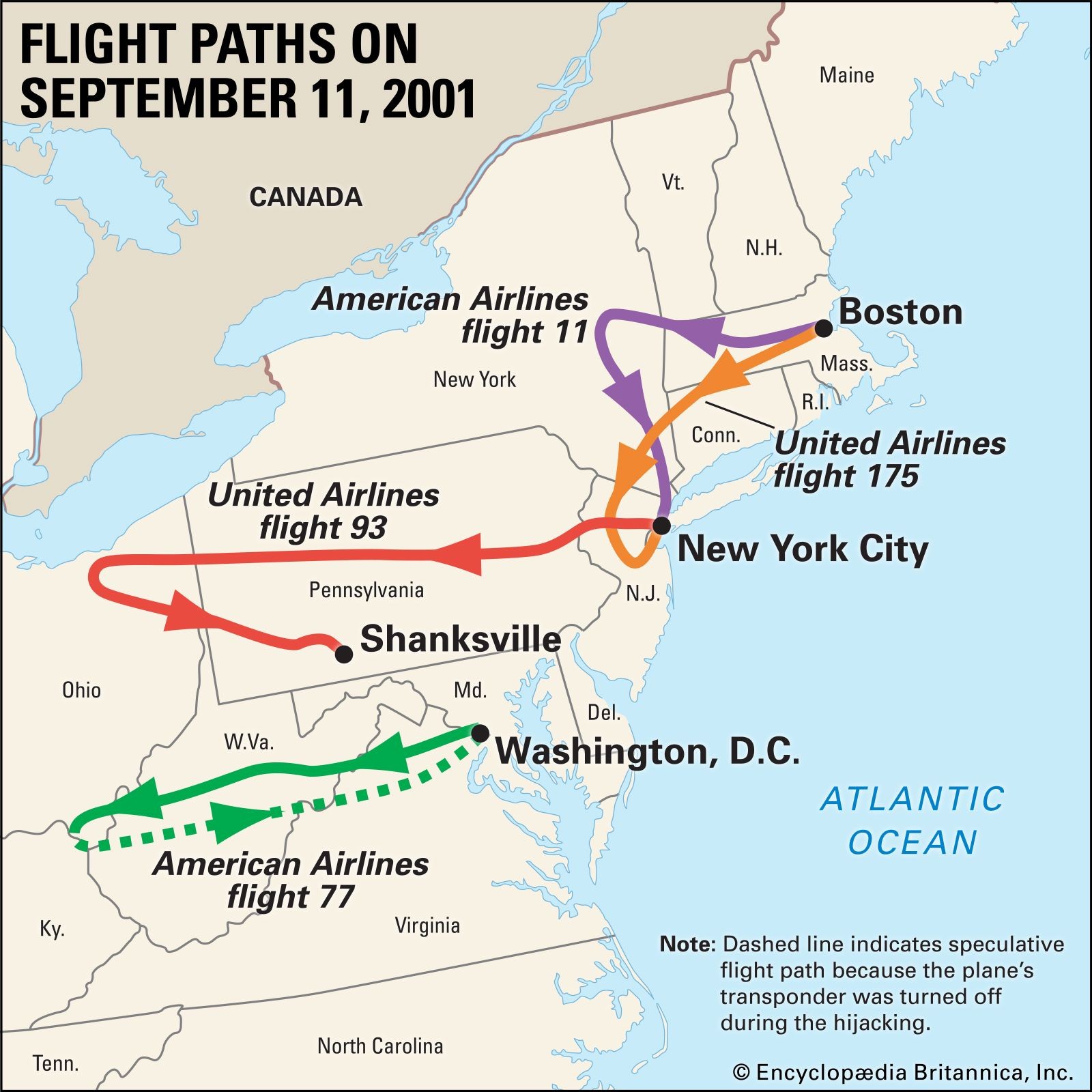The September 11 attacks, often referred to as 9/11, were a series of four coordinated terrorist attacks by the militant Islamic terrorist network al-Qaeda against the United States on the morning of Tuesday, September 11, 2001. The attacks resulted in 2,977 fatalities, over 25,000 injuries, and substantial long-term health consequences, in addition to at least $10 billion in infrastructure and property damage. But what is 9/11 beyond the statistics? This article delves into the planning and execution of this tragic event.
Flight paths of the four hijacked planes involved in the September 11, 2001 terrorist attacks, illustrating their intended targets.
The Genesis of the 9/11 Plot
The attacks were largely driven by Osama bin Laden’s miscalculations about the United States. Bin Laden, leader of al-Qaeda, believed America was weak, citing events like the Beirut marine barracks bombing in 1983 and the withdrawals from Somalia in 1993 and Vietnam in the 1970s as evidence. This perception fueled his ambition to strike at the heart of America.
Khalid Sheikh Mohammed: The Mastermind
The operational architect of the September 11 attacks was Khalid Sheikh Mohammed (KSM). He joined the Muslim Brotherhood at 16 and later studied in the United States, earning a degree from North Carolina Agricultural and Technical State University in 1986. After fighting against the Soviet Union in Afghanistan, KSM envisioned a grander scheme.
According to Al Jazeera journalist Yosri Fouda, KSM had planned to bomb a dozen American planes in Asia in the mid-1990s, known as the “Bojinka” plot. Though unsuccessful, this ambition persisted. In 1996, KSM met bin Laden in Tora Bora, Afghanistan.
The 9/11 Commission reported that KSM presented a plan to bin Laden involving pilots crashing planes into buildings in the United States. KSM conceived the tactic, al-Qaeda provided resources, and bin Laden integrated the attacks into a strategy to destabilize the Middle East by striking the “far enemy”—the United States. This collaboration highlighted al-Qaeda’s global reach.
Khalid Sheikh Mohammed, the principal architect behind the 9/11 terrorist attacks, as depicted in an official photograph.
Global Reach and Planning
The 9/11 plot spanned continents, with planning meetings in Malaysia, flight lessons in the U.S., coordination from Hamburg, Germany, financial transactions from Dubai, and recruitment from across the Middle East. All activities were overseen by al-Qaeda leaders in Afghanistan.
The Hamburg Cell and Mohammed Atta
Key aspects of the plot unfolded in Hamburg, Germany. Four key individuals, including lead hijacker Mohammed Atta, connected on a train in 1999 with an Islamist militant who suggested fighting jihad in Chechnya. This led them to an al-Qaeda operative who redirected them to Afghanistan.
Mohammed Atta’s Florida driver’s license, providing a glimpse into the identity of the lead hijacker of the September 11 attacks.
Radicalization and Training
The experiences of some plotters in the West were crucial. Three of the four 9/11 pilots and key planner Ramzi Binalshibh became more radicalized in Hamburg. Feelings of discrimination, alienation, and homesickness contributed to their militancy. Cutting themselves off, they radicalized each other and sought out al-Qaeda in Afghanistan in 1999.
Atta and his group arrived in Afghanistan as the 9/11 plot was forming. Bin Laden recognized their Western education and skills, appointing Atta to lead the operation.
The hijackers, primarily from Saudi Arabia, established themselves in the U.S., with some receiving flight training.
Communication and Code
Atta communicated with Binalshibh via email, disguising messages as correspondence with a girlfriend named “Jenny.” They used code to indicate progress. “Nineteen certificates” referred to the 19 hijackers, and “four exams” identified the targets.
In a coded phone call on August 29, 2001, Atta alluded to the date of the attacks, saying, “Two sticks, a dash and a cake with a stick down—what is it?” Binalshibh deciphered that 11-9 (September 11) was the intended date. On September 5, Binalshibh left Germany for Pakistan, sending word to bin Laden about the date and scope of the attacks.
The Legacy of 9/11
In conclusion, what is 9/11? It was a meticulously planned and executed terrorist attack driven by a complex mix of misperceptions, strategic ambition, and individual radicalization. The attacks demonstrated al-Qaeda’s global reach and the devastating consequences of extremist ideology. The events of that day forever changed the United States and shaped its foreign policy in the years that followed. The impact of 9/11 continues to be felt today.
